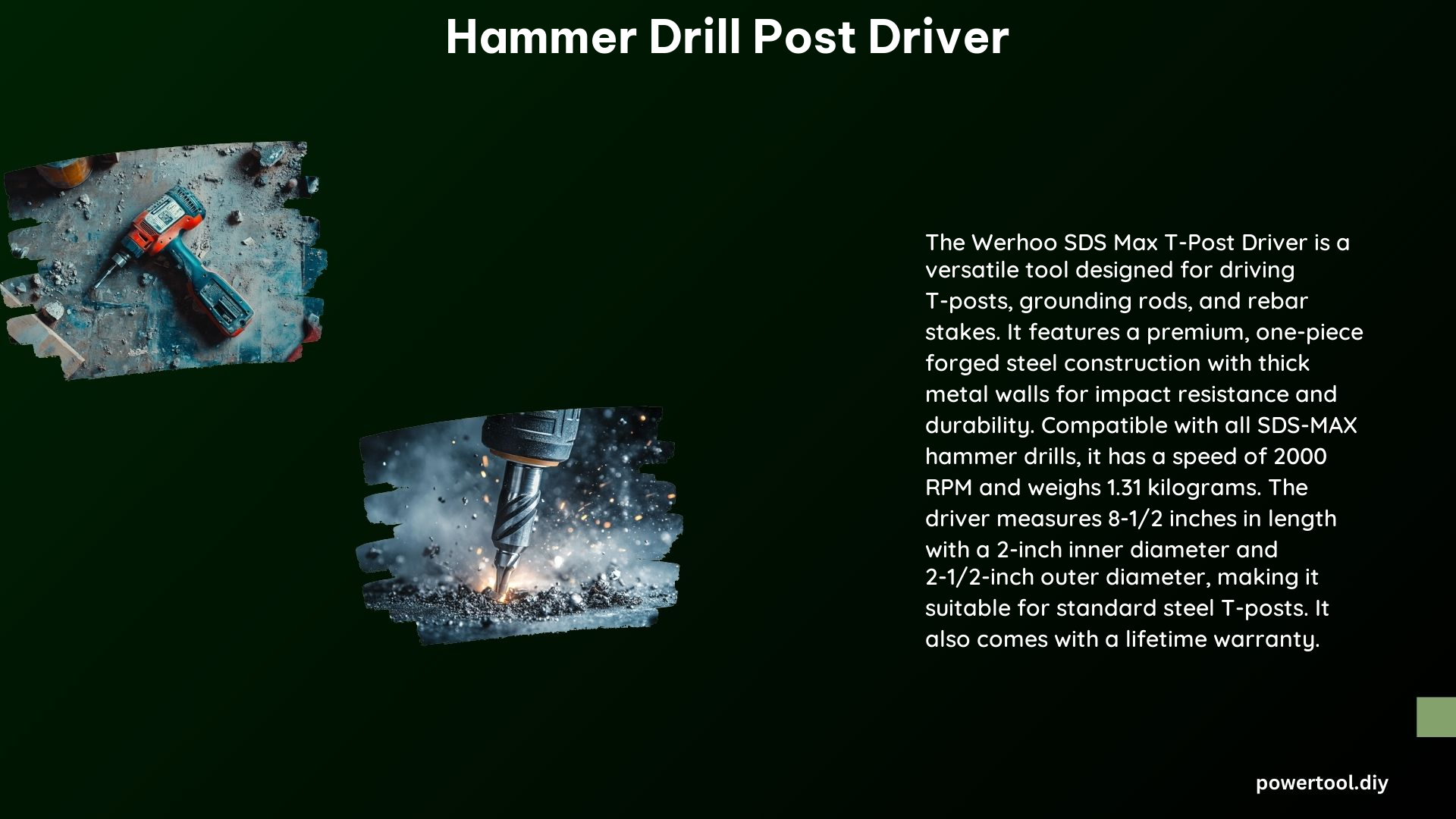A hammer drill post driver is a specialized tool designed to efficiently drive T-posts, grounding rods, and rebar stakes into the ground. This comprehensive guide will delve into the intricate details of hammer drill post drivers, providing you with a thorough understanding of their functionality, technical specifications, and optimal applications.
Primary Function and Advantages
The primary function of a hammer drill post driver is to rapidly and effortlessly drive various types of posts into the ground. These drivers are engineered to work seamlessly with rotary hammer drills, making them an indispensable tool for a wide range of construction and landscaping projects, such as:
- Fence Installation: Driving T-posts for fencing projects with unparalleled speed and precision.
- Grounding Rods: Efficiently installing grounding rods for electrical systems, ensuring proper grounding and safety.
- Rebar Stakes: Driving rebar stakes into the ground for construction projects, providing a sturdy foundation.
- Supporting Electrical Outlets: Quickly installing posts to support outdoor electrical outlets, enhancing safety and convenience.
The key advantages of using a hammer drill post driver include:
- Time-Saving: Dramatically reduces the time and effort required to drive posts into the ground compared to manual methods.
- Increased Efficiency: Allows for faster and more consistent post installation, improving project timelines.
- Versatility: Suitable for a wide range of post types, including T-posts, grounding rods, and rebar stakes.
- Ergonomic Design: Minimizes physical strain on the user, making post installation a more comfortable and manageable task.
Difference from Impact Drivers

While both hammer drill post drivers and impact drivers are power tools, they differ in several crucial aspects:
-
Design and Functionality: Hammer drill post drivers are specifically engineered for the sole purpose of driving posts into the ground, whereas impact drivers are more versatile and can be used for a variety of tasks, such as driving screws, nuts, and bolts.
-
Power and Speed: Hammer drill post drivers are typically more powerful and faster than impact drivers, as they need to generate significant force to effectively drive posts into the ground. This increased power and speed are essential for efficient post installation.
-
Shank Type: Hammer drill post drivers usually feature an SDS-MAX shank, which is compatible with rotary hammer drills. In contrast, impact drivers often have a different shank type, such as hex or square, which may not be compatible with the same range of power tools.
Technical Specifications
Hammer drill post drivers come with a range of technical specifications that cater to different project requirements and user preferences. Some of the key technical specifications include:
- Shank Type: SDS-MAX, which ensures compatibility with rotary hammer drills.
- Diameter: Typically ranging from 2 inches to 2.5 inches, providing options for various post sizes.
- Length: Available in lengths from 8 inches to 12 inches, allowing for versatility in post depth.
- Material: High-quality forged steel, ensuring durability and resistance to rust and corrosion.
- Weight: Typically around 1-2 kilograms, balancing power and maneuverability.
- Speed: Capable of reaching speeds up to 2000 RPM, enabling rapid post installation.
- Compatibility: Compatible with a wide range of rotary hammer drill brands, including Bosch, Dewalt, Hitachi, Hilti, Makita, and Milwaukee.
Optimal Applications and Usage
Hammer drill post drivers are designed to excel in tasks that require driving posts into the ground. Some of the most common and optimal applications include:
- Fence Installation: Driving T-posts for fencing projects, ensuring a sturdy and secure fence line.
- Grounding Rods: Installing grounding rods for electrical systems, providing essential safety and grounding.
- Rebar Stakes: Driving rebar stakes into the ground for construction projects, creating a stable foundation.
- Supporting Electrical Outlets: Quickly installing posts to support outdoor electrical outlets, enhancing safety and convenience.
When using a hammer drill post driver, it’s essential to follow the manufacturer’s instructions and safety guidelines to ensure optimal performance and user safety. Proper technique, such as maintaining a firm grip, aligning the driver with the post, and applying consistent pressure, can significantly improve the efficiency and accuracy of post installation.
Conclusion
Hammer drill post drivers are a specialized and indispensable tool for a wide range of construction, landscaping, and electrical projects. By understanding their primary function, technical specifications, and optimal applications, you can leverage these powerful tools to streamline your post installation tasks, saving time, effort, and resources. Whether you’re a professional contractor or a DIY enthusiast, mastering the use of a hammer drill post driver can greatly enhance your project outcomes and overall efficiency.
References:
1. https://texags.com/forums/34/topics/2966790
2. https://www.crowdersupply.com/post-driver-tools.htm
3. https://www.youtube.com/watch?v=xccwV-Y1mQM
4. https://www.amazon.com/Werhoo-SDS-Max-T-Post-Driver/dp/B0BQ3BTYMV
5. https://www.amazon.com/Sabre-Tools-Shank-Driver-Attachment/dp/B0BGQFYSDN
